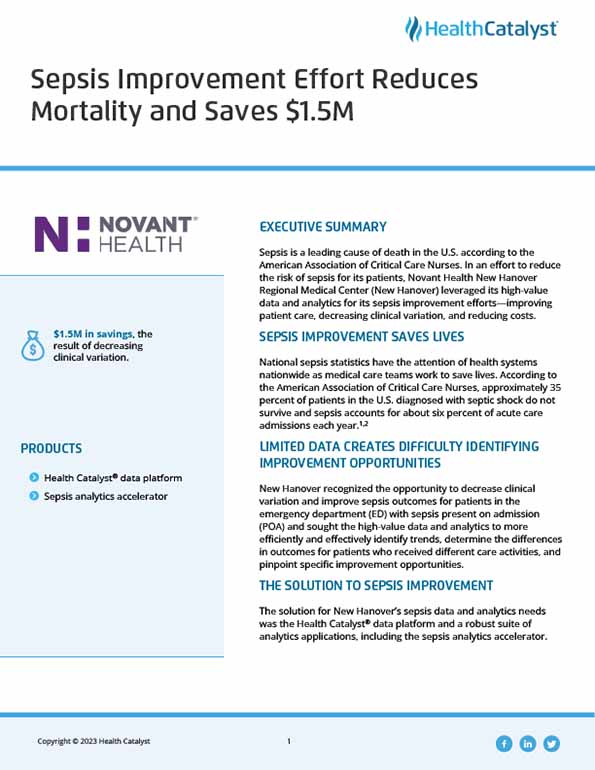Sepsis is a leading cause of death in the U.S. according to the American Association of Critical Care Nurses. In an effort to reduce the risk of sepsis for its patients, Novant Health New Hanover Regional Medical Center leveraged its high-value data and analytics for its sepsis improvement efforts—improving patient care, decreasing clinical variation, and reducing costs.
National sepsis statistics have the attention of health systems nationwide as medical care teams work to save lives. According to the American Association of Critical Care Nurses, approximately 35 percent of patients in the U.S. diagnosed with septic shock do not survive and sepsis accounts for about six percent of acute care admissions each year.1,2
Novant Health New Hanover Regional Medical Center (New Hanover) recognized the opportunity to decrease clinical variation and improve sepsis outcomes for patients in the emergency department (ED) with sepsis present on admission (POA) and sought the high-value data and analytics to more efficiently and effectively identify trends, determine the differences in outcomes for patients who received different care activities, and pinpoint specific improvement opportunities.
The solution for New Hanover’s sepsis data and analytics needs was the Health Catalyst® data platform and a robust suite of analytics applications, including the sepsis analytics accelerator.
With a compelling call to action and high-value data and analytics, the organization established a performance excellence sepsis improvement team, empowering clinicians and improvement experts to partner with improvement science methodologies to improve sepsis care and patient outcomes.
After analyzing the data, the team was able to visualize the difference in outcomes for patients who received all three-hour bundle elements versus those who did not. The organization easily identified the impact of individual bundle elements on outcomes, demonstrating the critical importance of timely antibiotic administration on outcomes and creating support for implementing standard care practices.
The performance excellence team implemented a new standard of care that calls for antibiotic administration within 60 minutes of sepsis recognition, evidence-based care for the first 24 hours of admission, and care expectations after the initial 24-hour period. The care pathway defines the criteria for intensive care unit (ICU) admission, helping ensure the right patients receive the right care in the right location and quickly.
New Hanover uses the analytics application to evaluate the effectiveness of improvement efforts and to quantify and communicate the impact of sepsis care standards and process changes on patient and organizational outcomes.
New Hanover’s data-informed improvement efforts are delivering the desired results. In just one year, the organization improved outcomes for patients with sepsis ED POA and achieved a:
"Using a robust improvement methodology and high-value data and analytics from the sepsis analytics accelerator, we were able to improve the quality of care provided to our patients, decrease clinical variation, and save $1.5M through reduced costs."
- Claire Corbett, MBA, Director, Performance Excellence, Novant Health
New Hanover will expand its data-informed improvement efforts across the organization, positively impacting more patients, decreasing clinical variation, and improving organizational performance. The performance excellence team continues to use the self-service sepsis analytics accelerator to monitor performance and identify new improvement opportunities, advancing a culture of continuous improvement.


